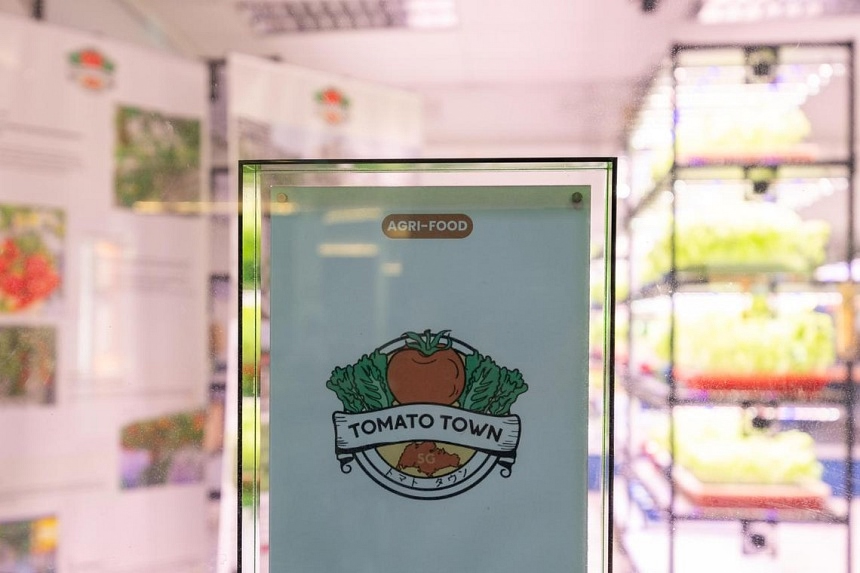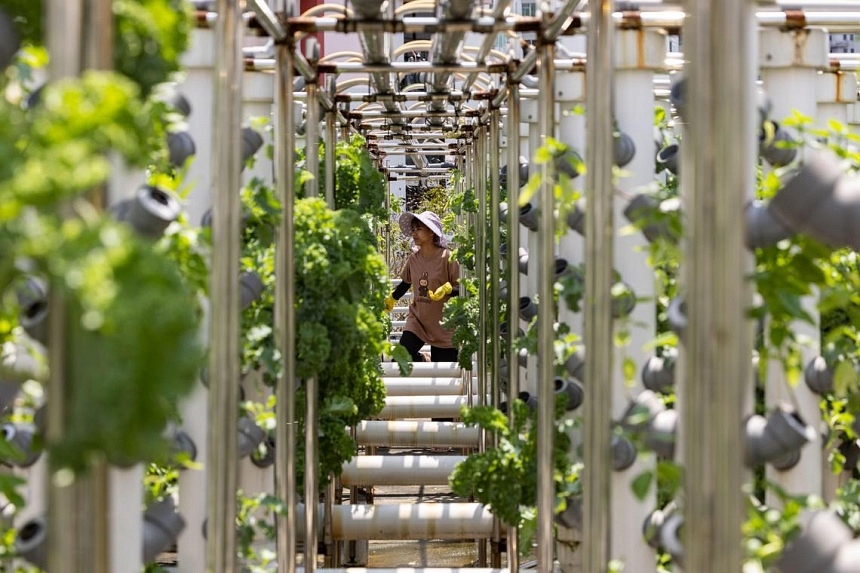October 15, 2024
SINGAPORE – Mr Webster Tham, co-founder of local agri-technology company Tomato Town, is looking to harvest Japanese cherry tomatoes and heirloom varieties of tomatoes through a collaboration with a Japanese company that makes tomato-based foods and vegetable juices.
By leveraging the Japanese firm’s farming expertise and using a special variety of its heat-resilient seeds, Mr Tham is hoping to grow tomatoes that can withstand Singapore’s hot and humid weather.
“There’s untapped potential there in that consumer tastes are converging towards these higher-end types of tomatoes, which are not readily available in the market and are mostly imported from Europe or Australia,” he said.
While the future is uncertain for local farms amid growing cost pressures and the lack of robust local demand, they are seeing opportunities to foster international collaboration, and seed the way forward.
The upcoming Lim Chu Kang masterplan, for instance, is designed to transform the farming district into a high-tech farming industry, with the Singapore Food Agency (SFA) looking to host best-in-class international players that are willing to anchor their operations in Singapore.
Tomato Town engaged a Japanese partner in March, Mr Tham said, because much of its efforts in the past to grow tomatoes had been “very trial and error”.
“We’ve been largely growing lettuce and kale, before dabbling in cherry tomatoes, which we’ve only been able to farm during the cooler months at the end of the year,” he said.
“So it’s good to have seasoned hands to guide us along the way.”
As tomato plants produce many leaves but far fewer fruit, the vine has to be regularly pruned to maximise its harvest, which also ensures that the fruits are larger and juicier.
But it takes a pair of expert hands to do this without killing the plant.
Mr Tham declined to name the Japanese partner due to commercial sensitivities. Tomato Town will sign a formal agreement with its counterpart in November.
Tomato Town’s seasonal crop of cherry tomatoes is supplied to Italian restaurants here.
But to take its tomatoes to supermarket shelves, the company would have to deliver a more consistent supply all year round, said Mr Tham.
For a start, it is aiming to produce around three tonnes of cherry tomatoes during the cooler months of October to January, before producing them all year round.
Growing these tomatoes locally could mean lower prices for the premium produce – a 250g truss of premium cherry tomatoes at Little Farms costs $7.98.
To keep production costs low, the tomato seedlings are grown in a controlled environment indoors – with indoor LED lights and a room temperature of 25 deg C.
They are moved outdoors once they reach a certain size. “By that time, they would be less vulnerable to pests and other environmental stresses, and can be grown till they are ready for harvest,” said Mr Tham.
The process takes around three to four months.
To work towards achieving Singapore’s 30 by 30 goal – producing 30 per cent of the country’s nutritional needs by 2030 – some farms like Tomato Town are working closely with international players to help bring the latter’s farming expertise and know-how to the Republic.
In early September, United Arab Emirates-based agri-food tech company Future Food Foundry invested US$20 million (S$26 million) to merge two local farms in Singapore – Sustenir and NextGen Farms – in order to “develop the largest plant superfood ecosystem in Singapore”.
Regarding the kind of strategic direction or expertise the UAE firm could provide to farms in Singapore, Mr Leo Musatov, its co-founder and managing director, said the UAE has done much work in developing controlled agriculture systems to feed its population, and has made great strides in these areas.
Both countries face similar challenges in food security due to limited arable land and are reliant on food imports, he noted.
“Our expertise allows us to enhance scalability and efficiency, ensuring that Singapore’s food security goals are met with the same level of precision and innovation that we’ve demonstrated in the UAE,” said Mr Musatov.
The company focuses on research and development (R&D), production, and distribution facilities in partnership with local government agencies in the UAE and Singapore.
Dr Mandar Godge, Future Food Foundry’s chief scientific adviser, said the goal would be to create an international ecosystem of high-tech farming companies, which would make it easier to share R&D innovations, and potential solutions that could benefit farms around the world.
Future Food Foundry is hoping to enter more markets to further its agricultural innovation by engaging their high-tech farms and research institutions. It currently has plans to establish new operating hubs in the Middle East, North Africa region and Asia-Pacific.

A close-up of Tomato Town’s logo outside its germination room at Vidacity. PHOTO: THE STRAITS TIMES
Dr Godge said the current focus in Singapore is to harvest nutrient-dense crops to feed its population.
Moving beyond the success of Sustenir, known for its kale enhanced with Gaba, an ingredient with anxiety-reducing properties, Future Food Foundry is looking into other high-demand crops, including baby spinach and rainbow chard, and fortifying them with added nutrients, he added.
The ideal would be to produce superfoods that can improve gut health and brain function, he said.
The production site will be at a facility in Sungei Tengah, where NextGen Farms is setting up operations, said Mr Musatov. The consolidated facility will operate under the Sustenir brand, and will be able to produce 1,500 tonnes of leafy greens annually from the second quarter of 2025.
“Sustenir’s existing site (in Admiralty) will continue to operate in parallel during this transition to ensure a seamless supply of crops,” he added.
Sustenir said it currently supplies more than three tonnes of spinach, kale, arugula and other salad greens and mixes to supermarkets and restaurants every week.
Although the details of the Lim Chu Kang masterplan are still being worked out, several international players have already been awarded land tenders by SFA to construct their farms at designated plots in Lim Chu Kang and Sungei Tengah.
Dr Bao Shengjie, co-founder of local precision agriculture firm Singrow, helped to bring Chinese mushroom farm Finc Bio-Tech to Singapore.
The Chinese company will build its farm on a 2ha plot in Sungei Tengah from the second half of 2025 to grow white button mushrooms.
The high-tech indoor farming company, which leverages automation and artificial intelligence, has decades of experience in growing shimeji mushrooms in China, said Dr Bao, who is also a shareholder in Finc Bio-Tech.
“White button mushrooms have a very short shelf life of fewer than three days, and these are often quite costly and of low quality by the time they arrive from the Netherlands and Malaysia,” he added.
Producing them locally could offer an opportunity for the company to price these mushrooms competitively, said Dr Bao.
The farm will be able to produce about 2,500 tonnes of white button mushrooms a year, accounting for around 40 per cent of local demand, he added.
In 2022, UAE-based Pure Harvest, which will be farming various varieties of tomatoes in Singapore, signed an agreement with the SFA to develop Singapore’s first high-tech hybrid greenhouse farm.
The low-cost facility will be able to utilise the “free” natural sunlight and overcome Singapore’s heat and humidity, which can create a challenging environment to farm high-quality fruits and vegetables, said its chief executive Sky Kurtz.
Pure Harvest is looking to begin construction in the coming months, after it has sorted out critical details such as the farm’s design and the project financing. If all goes well, the farm could be operational by late 2025.

Ms Sumyat Naing, 23, Tomato Town’s urban farmer, tending to the kale at the company’s farm in Lakeside. PHOTO: THE STRAITS TIMES
The memorandum of understanding between Pure Harvest and SFA will also enhance collaboration in protected agriculture, such as R&D exploration, knowledge exchange and capacity building.
Mr Kurtz said the details of the R&D agreement are still under development with potential partners and collaborators, but it will involve various areas such as developing plant genetics optimised for Singapore’s climate.
To share farming expertise and know-how, Pure Harvest will hire both local and regional talent to operate the business, as well as partner leading universities and technical institutes to maintain “a talent funnel” for future expansion, he added.
What benefits international players can bring to the local ecosystem depends on the model of collaboration, said agri-tech consultant Lee Eng Keat.
If overseas farms simply want to set up operations here, they will naturally compete with local players, although they may not have sufficient knowledge of the local market to successfully distribute their products, he noted.
Collaborating with local players could better help in the transfer of knowledge and expertise, especially when it comes to growing more “exotic” crops that are not typically farmed here.
The ideal is a tripartite collaboration between a local farmer, international player and a local research institute, which would then be the recipient of the farming know-how, said Mr Lee.
Local farms can then better work with their international counterparts to adapt their solutions to Singapore’s market, which has characteristics such as its hot and humid conditions, he added.


